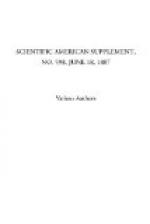Mr. Barnaby asked Mr. Linnington whether, in designing twin screws for a vessel of 8,000 i.h.p., he would make each screw, which would have to take 4,000 i.h.p., of the same diameter as a screw for a single ship of 4,000 i.h.p., of the same speed. Unfortunately in high speed vessels, from one point of view, the faster they went for a given power the smaller the diameter of the screw had to be, and the larger the pitch, so that in very high speed twin screw vessels the ratio of pitch to diameter would be found to come out very great indeed. In a twin screw torpedo boat, to be tried shortly, they had a ratio as high as 1.64. In the case of the Inflexible it was found, owing possibly to the position of the screw, that the whole of the plates immediately over the screws were damaged. Mr. Beckett Hill had been using, during the past three or four years, the twin screw steamers the Ludgate Hill, Richmond Hill, and Tower Hill. These were all over 4,000 tons register, and indicated, when at work at full speed, 2,500 h.p. Before he and his friends built these steamers, they built some very large tug boats on the twin screw principle. At the present moment, four of the fastest steamers building for the Atlantic service were to have twin screws. The great obstacle to the extension of the twin screw in the mercantile navy had been the fear that the projection of these screws would make the vessels very difficult to handle, but he had found no such difficulties. He had found it an advantage to put the point of the propeller as near the deadwood as he could, without actually touching it, and in the large steamers, as well as in the tugs, the distance was a few inches. As to the point of safety, he thought it a great advantage to have twin screws, and on two occasions twin screw vessels had met with accidents which, but for the twin screws, would have necessitated their putting back to New York for repairs. The Richmond Hill, on one occasion, met with an accident to her machinery two days after leaving New York; but she was able to come on with the second set of engines, and was only one day late in the passage. No difficulty had been found in the docking and undocking of these vessels, either in London or Liverpool, and while with single screw vessels they had sometimes to employ one or two dock boats to dock and undock them, they never had to do so with the twin screw vessels. These vessels were 400 ft. long, with 48 ft. breadth of beam—a very large size to handle in a river like the Thames. He noticed in the paper a propeller with a diameter of 15 ft. 6 in. to indicate 11,110 h.p., so that a great Atlantic steamer, which should indicate 11,000 or 12,000 h.p., and have a beam of about 65ft., would have her screws very well protected.




